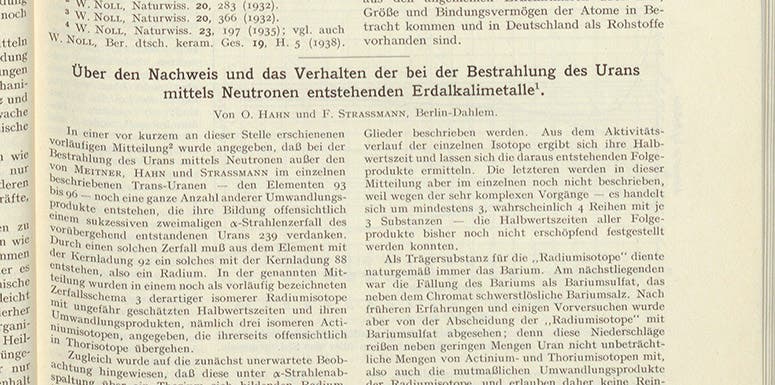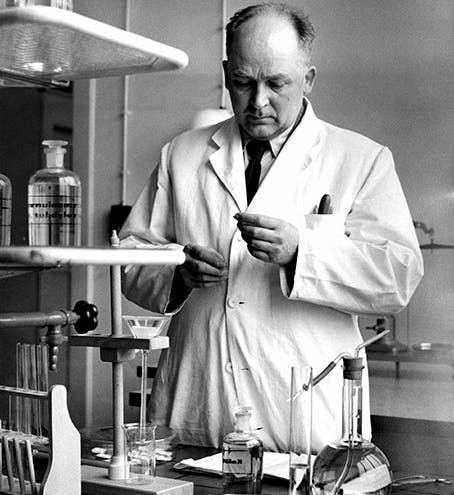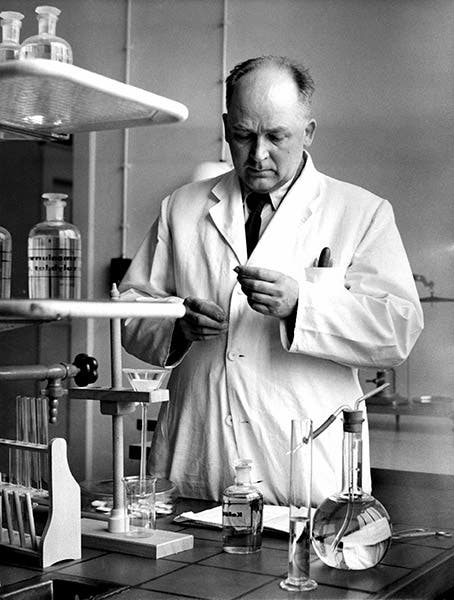Scientist of the Day - Fritz Strassmann
Frederick Wilhelm (Fritz) Strassmann, a German physical chemist, was born Feb. 22, 1902. Strassmann showed great aptitude for chemistry as a young man, but when his father died, he decided to enroll at a technical institute rather than a university, with plans for going into industrial chemistry. He received his PhD at Hannover Technical University in 1929 and secured a scholarship to pursue further studies at the Kaiser Wilhelm Institute for Chemistry in Dahlem in Berlin (second image). The Institute was directed by Otto Hahn, one of the pioneers of radiochemistry, the chemical study of uranium, radium, and other radioactive materials. Strassmann was adamantly opposed to Nazism and resigned from the German Society of Chemists when it became affiliated with the new Nazi government in 1933. As a result, he was not allowed to pursue his habilitation, the highest university degree in Germany and a prerequisite for a professorship. He was effectively cut off from academic employment. Hahn kept him on at his Institute, first by renewing his scholarships, and then by employing him in his own lab. The Institute was supported primarily by the private sector and relatively immune to government interference, so Strassmann stayed under the radar. In 1935, Hahn and Lise Meitner began exploring what happens to uranium when it is impacted by slow neutrons, and Strassmann was invited to work with them.
Experimenters in Italy (under Enrico Fermi) and Paris (under Irène Joliot-Curie) had discovered that new radioactive elements were created when uranium and radium were bombarded with neutrons that had been slowed down by paraffin. Fermi thought he had created trans-uranic elements – heavier than uranium – and he received the Nobel Prize in 1938 for this achievement (although it turned out he had not made trans-uranics after all). Curie's group also created a number of new isotopes or elements – they identified ten different half-lives, suggesting ten different isotopes, probably of radium, but they could not identify them. Hahn, Meitner, and Strassmann pursued the same kind of experiments in Dahlem in 1937-38. Meitner, an Austrian Jew, had to flee to Holland and then Sweden in 1938 when Hitler annexed Austria (and Meitner was suddenly subject to Germany’s restrictive laws against Jews), but Hahn and Strassmann continued the work and kept Meitner informed. They thought they were creating new isotopes of radium with their uranium bombardment. Strassmann was the analytic chemist of the trio (now duo), and his job was to identify these new elements or isotopes by chemical separations and precipitations. In December of 1838, in one his attempts to identify an unknown radium isotope, he used barium as a carrier (radium is often dragged along in barium reactions, because radium and barium are chemically similar). But Strassman was then unable to separate the new element from the barium. It resisted all of the chemical weapons in his arsenal. It was almost as if the new element was barium, which was of course impossible, since barium has an atomic number of 56, while uranium’s is 92, and there was thought to be no way a uranium atom could spit out a barium atom as the result of a neutron impact.

The beginning of the paper by Otto Hahn and Fritz Strassmann published in Naturwissenschaften, vol. 27, Jan. 6, 1939. The title translates as “On the detection and behavior of the alkaline earth metals formed when uranium is irradiated with neutrons (Linda Hall Library)
But that is just what had happened. The atom had been split, and barium was one of the byproducts. This was figured out by Meitner in Denmark, with the help of her nephew Otto Frisch, both on a Christmas vacation, after Meitner received a letter from Hahn describing the experiments. Frisch offered the name fission to describe what had happened. The results of Strassmann's analysis was published in a joint paper with Hahn in the journal Naturwissenschaften, without the conclusions of Meitner and Frisch, because the paper was submitted to the editor just before Christmas (third image). But by the time the paper was published on Jan. 6, 1939, the word had spread through Bohr’s network that the atom could be split, a discovery that would drastically change the world, and, by 1945, the outcome of the war that was just on the horizon at the time of the paper’s publication.
Hahn would receive the 1944 Nobel Prize in Chemistry, awarded in 1945, for the discovery of nuclear fission. Strassmann, curiously, did not share in the award, and even more curiously, neither did Meitner, who had been an indispensable colleague of Hahn’s throughout the uranium bombardment experiments, until she was forced out of Germany. But Meitner was a physicist, not a chemist. Strassmann was junior enough that he was probably not considered for a share, but Hahn always gave him full credit for the chemical analysis, and it was, after all, Strassmann’s analysis that revealed that the atom had been split.
The Deutsches Museum in Munich has long had a display which they originally called Otto Hahn’s Worktable, the purpose being to demonstrate that you could split the atom with equipment that would fit on a kitchen table. We showed it in our post on Hahn, or you can see it here. They really need another, much bigger table to represent Strassman’s lab, which was quite separate from the irradiation room, and which was where barium was first identified by Strassmann as a byproduct of nuclear fission.
To me, the most admirable aspect of Strassmann’s career was his firm and continuous opposition to the policies of Nazi Germany, in an environment where such opposition was very difficult. Hahn had to put up with policies he did not like, to keep his position, and to keep the Institute open. Strassmann never accommodated, never worked on the German bomb effort, saying he would die before he helped Hitler develop a bomb, and as a result he had to work as an underpaid assistant for almost 15 years. Fortunately, when the war was over, his career flowered; he became professor of nuclear chemistry at the University of Mainz, and director of the Kaiser Wilhelm Institute for Chemistry, after it moved to Mainz and changed its name to the Max Planck Institute for Chemistry. He founded his own Institute for Nuclear Chemistry at Mainz in 1967. He died on Apr. 22, 1980 at the age of 78, with his accomplishments fully appreciated.
There is a great deal of literature on the discovery of fission, but in my opinion, one of the clearest explanations for the general reader of Strassmann’s role (and the role of Fermi, Joliot-Curie, Hahn, Meitner, and Frisch) is still The Making of the Atomic Bomb (1986), by Richard Rhodes, chapter 9: “An extensive burst.” This admirable book was mostly written and researched by Mr. Rhodes in our Library.
William B. Ashworth, Jr., Consultant for the History of Science, Linda Hall Library and Associate Professor emeritus, Department of History, University of Missouri-Kansas City. Comments or corrections are welcome; please direct to ashworthw@umkc.edu.








